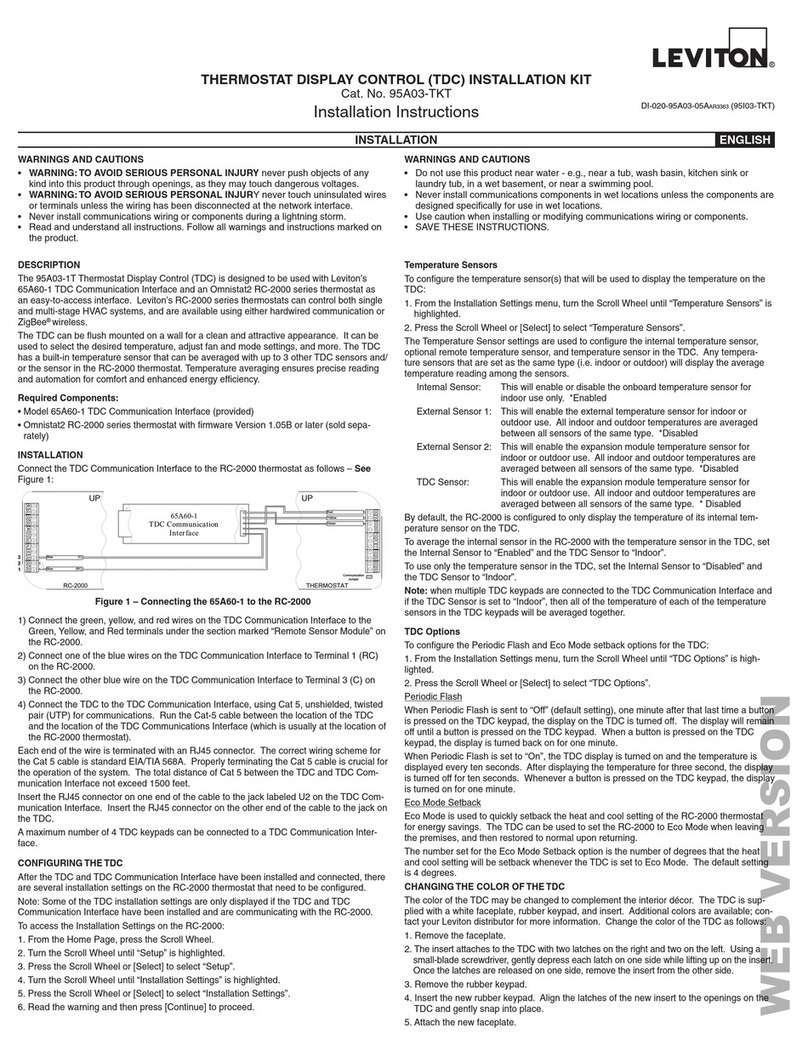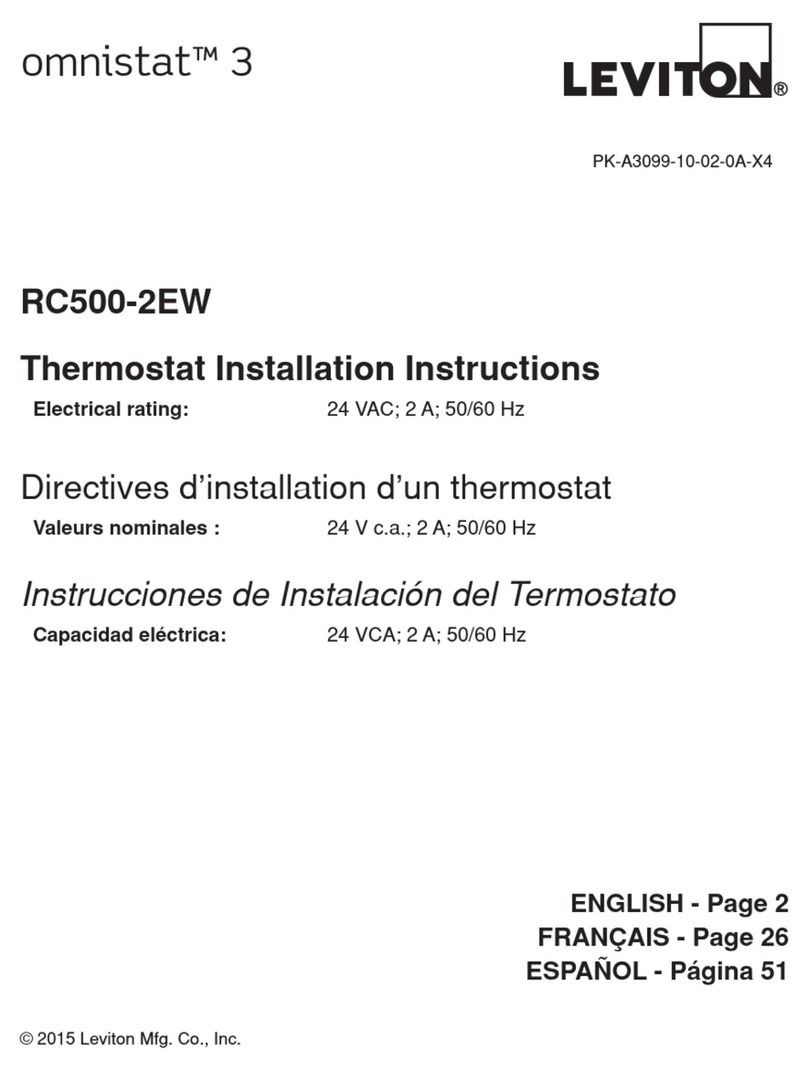
THERMOSTAT DISPLAY CONTROL (TDC)
Cat. No. 95A03-TWH
Installation Instructions
INSTALLATION ENGLISH
DESCRIPTION
The 95A03-TWH Thermostat Display Control (TDC) is designed to be used with
Leviton’s 65A60-1 TDC Communication Interface and an Omnistat2 RC-2000 series
thermostat as an easy-to-access interface. Leviton’s RC-2000 series thermostats
can control both single and multi-stage HVAC systems, and are available using either
hardwired communication or ZigBee wireless.
The TDC can be flush mounted on a wall for a clean and attractive appearance. It can
be used to select the desired temperature, adjust fan and mode settings, and more. The
TDC has a built-in temperature sensor that can be averaged with up to 3 other TDC
sensors and/or the sensor in the RC-2000 thermostat. Temperature averaging ensures
precise reading and automation for comfort and enhanced energy efficiency.
Required Components:
• Model 65A60-1 TDC Communication Interface
• Omnistat2 RC-2000 series thermostat with firmware Version 1.05B or later
INSTALLATION
The (TDC) connects directly to a TDC Communication Interface (65A60-1) using Cat 5,
unshielded, twisted pair (UTP) for communications. Each end of the wire is terminated
with an RJ45 connector. The correct wiring scheme for the Cat 5 cable is standard EIA/
TIA 568A. Properly terminating the Cat 5 cable is crucial for the operation of the system.
The total distance of Cat 5 between the TDC and TDC Communication Interface not
exceed 1500 feet.
Insert the RJ45 connector on one end of the cable to the jack labeled U2 on the TDC
Communication Interface. Insert the RJ45 connector on the other end of the cable to
the jack on the TDC.
A maximum number of 4 TDC keypads can be connected to a TDC Communication
Interface.
CONFIGURING THE TDC
After the TDC and TDC Communication Interface have been installed and connected,
there are several installation settings on the RC-2000 thermostat that need to be
configured.
Note: Some of the TDC installation settings are only displayed if the TDC and TDC
Communication Interface have been installed and are communicating with the RC-2000.
To access the Installation Settings on the RC-2000:
1. From the Home Page, press the Scroll Wheel.
2. Turn the Scroll Wheel until “Setup” is highlighted.
3. Press the Scroll Wheel or [Select] to select “Setup”.
4. Turn the Scroll Wheel until “Installation Settings” is highlighted.
5. Press the Scroll Wheel or [Select] to select “Installation Settings”.
6. Read the warning and then press [Continue] to proceed.
Temperature Sensors
To configure the temperature sensor(s) that will be used to display the temperature on
the TDC:
1. From the Installation Settings menu, turn the Scroll Wheel until “Temperature
Sensors” is highlighted.
2. Press the Scroll Wheel or [Select] to select “Temperature Sensors”.
The Temperature Sensor settings are used to configure the internal temperature
sensor, optional remote temperature sensor, and temperature sensor in the TDC. Any
temperature sensors that are set as the same type (i.e. indoor or outdoor) will display
the average temperature reading among the sensors.
Internal Sensor: This will enable or disable the onboard temperature sensor for
indoor use only. *Enabled
External Sensor 1: This will enable the external temperature sensor for indoor or
outdoor use. All indoor and outdoor temperatures are averaged
between all sensors of the same type. *Disabled
External Sensor 2: This will enable the expansion module temperature sensor for
indoor or outdoor use. All indoor and outdoor temperatures are
averaged between all sensors of the same type. *Disabled
TDC Sensor: This will enable the expansion module temperature sensor for
indoor or outdoor use. All indoor and outdoor temperatures are
averaged between all sensors of the same type. * Disabled
By default, the RC-2000 is configured to only display the temperature of its internal
temperature sensor on the TDC.
To average the internal sensor in the RC-2000 with the temperature sensor in the TDC,
set the Internal Sensor to “Enabled” and the TDC Sensor to “Indoor”.
To use only the temperature sensor in the TDC, set the Internal Sensor to “Disabled”
and the TDC Sensor to “Indoor”.
Note: when multiple TDC keypads are connected to the TDC Communication Interface
and if the TDC Sensor is set to “Indoor”, then all of the temperature of each of the
temperature sensors in the TDC keypads will be averaged together.
TDC Options
To configure the Periodic Flash and Eco Mode setback options for the TDC:
1. From the Installation Settings menu, turn the Scroll Wheel until “TDC Options” is
highlighted.
2. Press the Scroll Wheel or [Select] to select “TDC Options”.
Periodic Flash
When Periodic Flash is sent to “Off” (default setting), one minute after that last time a
button is pressed on the TDC keypad, the display on the TDC is turned off. The display
will remain off until a button is pressed on the TDC keypad. When a button is pressed
on the TDC keypad, the display is turned back on for one minute.
When Periodic Flash is set to “On”, the TDC display is turned on and the temperature
is displayed every ten seconds. After displaying the temperature for three second, the
display is turned off for ten seconds. Whenever a button is pressed on the TDC keypad,
the display is turned on for one minute.
Eco Mode Setback
Eco Mode is used to quickly setback the heat and cool setting of the RC-2000
thermostat for energy savings. The TDC can be used to set the RC-2000 to Eco Mode
when leaving the premises, and then restored to normal upon returning.
The number set for the Eco Mode Setback option is the number of degrees that the
heat and cool setting will be setback whenever the TDC is set to Eco Mode. The default
setting is 4 degrees.
CHANGING THE COLOR OF THE TDC
The color of the TDC may be changed to complement the interior décor. The TDC
is supplied with a white faceplate, rubber keypad, and insert. Additional colors are
available; contact your Leviton distributor for more information. Change the color of the
TDC as follows:
1. Remove the faceplate.
2. The insert attaches to the TDC with two latches on the right and two on the left.
Using a small-blade screwdriver, gently depress each latch on one side while lifting
up on the insert. Once the latches are released on one side, remove the insert from
the other side.
3. Remove the rubber keypad.
4. Insert the new rubber keypad. Align the latches of the new insert to the openings on
the TDC and gently snap into place.
5. Attach the new faceplate.
DI-031-95A03-05AAR3363 (95I03-1T)
WARNINGS AND CAUTIONS
• WARNING: TO AVOID SERIOUS PERSONAL INJURY never push objects of any
kind into this product through openings, as they may touch dangerous voltages.
• WARNING: TO AVOID SERIOUS PERSONAL INJURY never touch uninsulated wires
or terminals unless the wiring has been disconnected at the network interface.
• Never install communications wiring or components during a lightning storm.
• Read and understand all instructions. Follow all warnings and instructions marked on
the product.
WARNINGS AND CAUTIONS
• Do not use this product near water - e.g., near a tub, wash basin, kitchen sink or
laundry tub, in a wet basement, or near a swimming pool.
• Never install communications components in wet locations unless the components are
designed specifically for use in wet locations.
• Use caution when installing or modifying communications wiring or components.
• SAVE THESE INSTRUCTIONS.
























